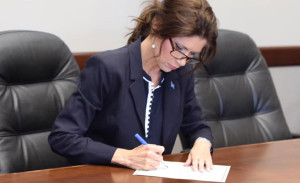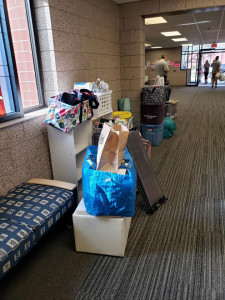A Historical Look At These Historic Times
Deaths in China and even in Washington State seemed like nothing more than a distant news story, but seemingly overnight, COVID-19 became the what that affected the life of every American.
At South Dakota State University, that meant an extended spring break, classes resuming online, nearly all employees working from home and a bevy of outreach efforts to help people dealing with various social and economic side effects from the pandemic.
The following timeline gives an encapsulated look back at this historic period.
December
Dec. 31, 2019: News reports started circulating that health authorities were treating dozens of cases of pneumonia in Wuhan, Hubei Province. Days later, researchers in China identify the new coronavirus.
 January
January
Jan. 11, 2020: Chinese state media report the first known death from the virus.
Jan. 21: First case is reported in the United States—a man in Washington State developed the symptoms after returning from Wuhan.
Jan. 22: Most Jackrabbits fans were focusing on beating North Dakota State in men’s basketball and if it would snow the coming weekend. Meanwhile, Gov. Kristi Noem’s ’11 office began regular meetings on COVID-19. Campus emergency management leaders met with International Affairs and Student Health regarding possible travel restrictions.
Two days later, the SDSU emergency management team leader calls a meeting with the full committee regarding COVID-19.
February
For everyone else, it’s only a story out of China. By Feb. 11, one month after the first reported death in China, the death toll there reached 1,113 with total cases at 44,653. Outside of China, there were only 393 cases.
March
A month later, the virus slipped into South Dakota.
March 10: Noem announced the first four cases and one death. Quickly, life in the Rushmore State changed.
March 13: Noem ordered state employees to work at home unless they’re deemed an essential employee. The Board of Regents did the same and extended spring break through March 20. Many private employers also told employees to work from home and business lobbies were closed to enforce social distancing.
March 15: The Centers for Disease Control and Prevention recommended gatherings of no more than 50 people. That soon was dropped to 10 as COVID-19 spreads nationally.
On campus, the university’s COVID-19 response team met twice daily March 16-19. During the week of March 16, there were 324 faculty members trained on online instruction during 24 workshops in five days.
The following week, any hope of a quick return to normalcy was dashed. The Board of Regents announced that face-to-face classes wouldn’t resume this semester. All courses will be delivered remotely and on-campus students received a refund for room, board and parking.
Addressing student needs
While it felt like the sidewalks had been rolled up on campus, plenty of outreach remained.
The Student Health and Counseling Center was open from 9 a.m. to 3 p.m. Monday through Friday to allow students to speak with counselors and receive medical attention.
Jack’s Cupboard, the campus food pantry, allowed students still in the community to obtain food and other items they can’t afford during the pandemic. Housing and Residential Life collected donations from students while they were moving out of the residence halls.
Housing and Residential Life created a phased checkout plan for those students who had been living in the residence halls prior to the extended spring break to come back to campus to obtain their belongings. Students were given designated days and time periods based on their hall, floor and room number to move out within a two-week span—March 30 to April 9. Residence hall floors were vacated individually and by even- or odd-numbered rooms to maintain social distancing.
 April
April
Students were also given the option to make individual appointments to move out April 15 to May 8. Nearly 75% of students who were living on campus before spring break had vacated by April 9.
The SDSU Foundation also addressed student financial needs with two crowdfunding efforts. It organized Rabbit Raisers for Jack’s Cupboard and a Student Emergency Fund. For example, a $25 donation covered the average cost of items a student picks up during a visit to Jack’s Cupboard. The Student Emergency Fund reached $15,000 April 1.
Summer is always a quiet time on campus and this year it will be even quieter.
April 6: It was announced campus events were canceled until Aug. 15. That included the 50th season of Prairie Repertory Theatre, athletic and academic camps, incoming student visitations and weddings
at McCrory Gardens.
In an April 14 message to his campus colleagues, SDSU President Barry Dunn wrote, “The course of these next several months will be a defining time for SDSU, and our courage, integrity, dedication and judgment will be tested. But together we will continue to prevail. It is our collective effort that will make a difference in how our university is judged 50 years from now when history is written.â€
– Dave Graves






